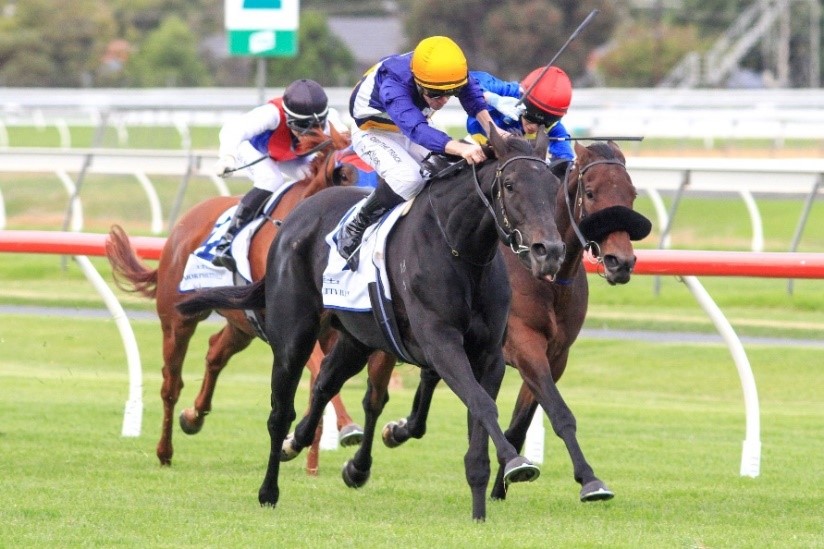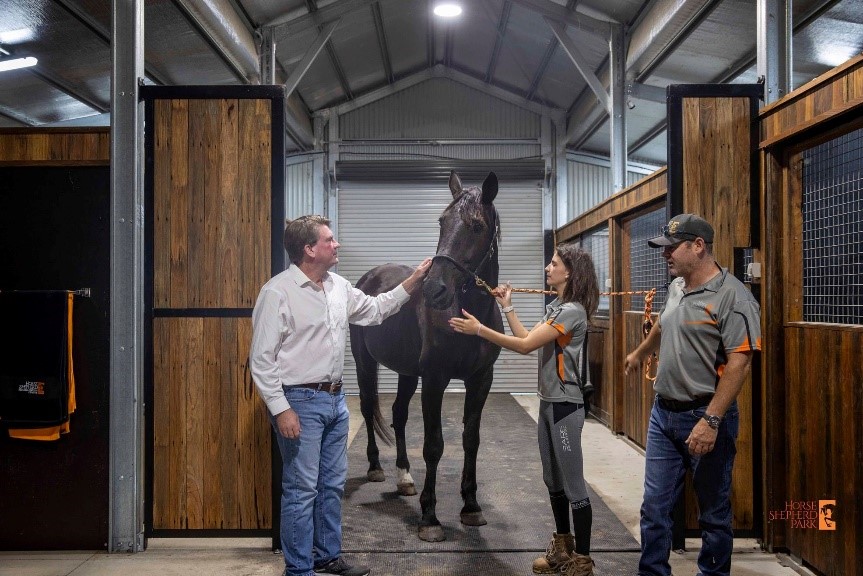Chaperonze® Research History
It started with Horses
Horse Races and Growth Hormone Axis.
 Kentucky-based, Dr Padraig O’Casaigh BVSc, PhD, MRCVS, began his journey towards discovering Chaperonze® when he was just a boy in New Zealand. It was a family tradition to attend the local horse races when he was growing up and he became interested, not only in the horse, but in whom their parents were and the common traits between mare, sire and foal. He was a keen animal lover and wanted to become a veterinarian from the age of four.
Kentucky-based, Dr Padraig O’Casaigh BVSc, PhD, MRCVS, began his journey towards discovering Chaperonze® when he was just a boy in New Zealand. It was a family tradition to attend the local horse races when he was growing up and he became interested, not only in the horse, but in whom their parents were and the common traits between mare, sire and foal. He was a keen animal lover and wanted to become a veterinarian from the age of four.
In 1989, at the age of 21, and after graduating from Veterinary School, he was offered an internship in Equine Surgery at the best Veterinary practice in the world, Hagyard, Davidson and McGee, (now Hagyard Institute), located in Lexington, Kentucky, USA. On his third day in Lexington, he visited a breeding farm to see the grandfather of a stallion he had followed for many years in New Zealand. Incidentally, that day he met Dr Umphenour, who became a friend of 30 years and is one of the non-clinical subjects, currently using Chaperonze®.
 From Kentucky, Dr O’Casaigh was selected to do his clinical residency in Equine Reproduction at the University of California, Davis. He immediately began his research into stallions and fertility which continues today.
From Kentucky, Dr O’Casaigh was selected to do his clinical residency in Equine Reproduction at the University of California, Davis. He immediately began his research into stallions and fertility which continues today.
Dr O’Casaigh’s research group was the first to determine that the Growth Hormone (GH) axis was a key factor in male fertility/subfertility in all mammals. The group was the first to establish treatment protocols to manipulate this axis, leading to success in treating male fertility.
Dr O’Casaigh, Dr Umphenour and Rich Decker, Director of Prestonwood Farms, successfully treated some high-profile stallions in Kentucky, (nowadays, it is no longer allowed to use GH, clinically, in horses). They were met, however, with a group of older stallions that would not respond, clinically, to GH.
This puzzled Dr O’Casaigh triggering a desire to find out why.
Growing New Cells.
With the advent of the cell culture in a test tube that came about in the 1950’s, it was believed that once a cell had been ‘released’ from the constriction or encapsulation of an organ, that it would divide. This was soundly based on the fact that as cells within organs encounter this constriction in a developing empyo/fetus, they stop dividing. To the dismay of scientists, the cells that were put into a cell culture would live ‘quite happily’, but would not divide.
Dr O’Casaigh pondered the possible reasons behind this and an abiding question was: ‘did the cells in a cell culture feel that had no need to divide?’
Cell division is a vital biological process and as part of his research, Dr O’Casaigh had been studying how Spermatogonial stem cells in the testicles, divide to produce new sperm. The interesting thing in this process was that the sperm making system had an opening from which the new sperm was released, hence no constricture.
Dr O’Casaigh wondered if the cells continued to divide, because they had not been biologically ‘told’ to stop. His next question to himself was: ‘how do you ‘tell’ a cell that has stopped dividing, (like a tendon cell or a heart cell), that it can start again?’
Dr O’Casaigh found the answer to this question by observing the environment around him. Biological systems show regrowth after receiving an ‘insult’. A few examples of this phenomenon are: pruning roses; tree regrowth after a wild fire; athlete’s altitude training.
This discovery led to Dr O’Casaigh’s patent for Method for Growing Adult Cells, which can be viewed by clicking the following link:
https://patents.google.com/patent/US8372644
Once a cell’s very mortality is threatened, that signals it to start dividing. Moreover, these cells behave as if they are brand new cells.
How is this possible? The answer lies within the cell. The proteins that actively regulate the cell and eliminate cellular waste are lost with age. These proteins are called Chaperone Proteins (CP). The new cells grown in-vitro by Dr O’Casaigh’s patented method, are packed with CP.
Developing the Unified Theory of Aging.
 As Chaperone Proteins (CP) are lost with age, our cells become more and more packed with ‘junk protein’. There is a marked increase in free radicals as well, (see Cellular Rejuvenation & Repair in the About Chaperonze® section of the website Menu). The cell’s ability to make new proteins is impeded by the fact it contains too much ‘junk’. The cell’s DNA has not changed, but its ‘message’ cannot be translated to ignite new CPs because the system has dramatically slowed down.
As Chaperone Proteins (CP) are lost with age, our cells become more and more packed with ‘junk protein’. There is a marked increase in free radicals as well, (see Cellular Rejuvenation & Repair in the About Chaperonze® section of the website Menu). The cell’s ability to make new proteins is impeded by the fact it contains too much ‘junk’. The cell’s DNA has not changed, but its ‘message’ cannot be translated to ignite new CPs because the system has dramatically slowed down.
Dr O’Casaigh’s thoughts went to those stallions that were unresponsive to GH therapy in old age. Hormones are made from proteins, Maybe, he theorized, those older stallions were unable to respond to GH therapy because their cells were too clogged with ‘junk’.
The question now in Dr O’Casaigh’s mind was: “how do we get rid of the cellular ‘junk’ in order to allow the cell to make more proteins?”
He became convinced that the answer lay with replacing lost CPs.
Dr O’Casaigh had two specific target modalities in mind – anti-aging for general health and specific targeting for severe cellular dysfunction.
Three model species were used to achieve this clinically – horse, human and cat – and one model species was used for the extraction of CP for clinical use – Sheep.
The steps that Dr O’Casaigh established to accomplish the delivery of a working science and to provide the necessary protocols are detailed below:
a) Identify a source of Chaperone Protein (CP) and extract the protein. The key to the science is how to extract the CP from the Ovine Feto-Placental unit whilst making sure that the proteins are fully intact and biologically functional. It is made in New Zealand from naturally sourced Ovine Placenta, under NZ Government (MPI) supervision to ensure its quality and purity.
b) Develop a safe and efficacious methodology to provide individuals with CP. Using the horse as a model species, Dr O’Casaigh has been able to establish bio-markers for the identification of efficacious results. The horse is well known for its sensitive immune system and therefore serves as a good safety model. There have been no known negative effects in any of the horse, human or cat samples.
c) Develop a method of monitoring, (blood testing). Dr O’Casaigh and his research team were able to combine three essential biomarkers together and establish the interaction between them. To achieve this, they established a high quality, multi-species laboratory, employing high calibre analysts. They used these markers to establish efficacious regimens and the development of research monitoring techniques.
d) Make Chaperonze® commercially available to the world. Dr O’Casaigh and his team have developed a safe, efficacious product that can help favourably alter the Chaperone Protein Axis in individuals. In functional terms, Chaperonze® is able to help unclog patient’s cells, thus allowing them to function more efficiently. Patients literally experience a reversal of cellular aging.
The Two Specific Treatment Modalities.
 Anti-Aging for General Health. Chaperonze® is a unique product, unlike any other available in the world, currently. This product works naturally inside the body helping cells to repair themselves and regenerate. Chaperonze® targets the CAUSES of cellular aging, rather than the SYMPTOMS.
Anti-Aging for General Health. Chaperonze® is a unique product, unlike any other available in the world, currently. This product works naturally inside the body helping cells to repair themselves and regenerate. Chaperonze® targets the CAUSES of cellular aging, rather than the SYMPTOMS. Specific Targeting of Severe Cellular Dysfunction. Storage diseases created by protein dysfunction can be targeted with Chaperone Proteins.
Specific Targeting of Severe Cellular Dysfunction. Storage diseases created by protein dysfunction can be targeted with Chaperone Proteins.
Made in New Zealand then packaged along with an organic, specialised Protein Transfer Oil, Chaperonze® is available for purchase from Cellhealth Proteins Ltd.